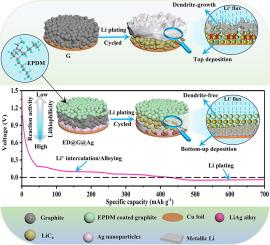Double-gradient host enabling bottom-up Li deposition towards hybrid lithium-ion/metal anode with long lifespan
IF 13.3
1区 工程技术
Q1 ENGINEERING, CHEMICAL
引用次数: 0
Abstract
The graphite-based hybrid Li-ion/metal anode holds great promise to be one of the ultimate anode choices, owing to its high specific capacity (often up to 500 mAh/g), obviously superior to 372 mAh/g of the commercial graphite anode. Unfortunately, Li deposition on the top surface of the conductive graphite host can easily drive Li dendrite growth, dead Li accumulation, and the blockage of Li+ transport pathways, leading to low host space utilization and cycling stability deterioration. Herein, a graphite host with lithiophilicity and reactive activity dual-gradient is constructed by integrating a surface insulation passivation and a bottom lithiophilicity modification to realize the “bottom-up” deposition behavior for hybrid Li-ion/metal anode. The conformal coating layer of electrical insulating and lithiophobic polymer can efficiently retard Li+ reduction and deposition on the top surface of the conductive host, while the decorated Ag nanoparticles with high lithiophilicity on the host bottom enable much lower Li nucleation barrier, thereby guiding the preferential bottom-up Li deposition. Li dendrite growth is effectively inhibited and the synergistic effects realize high space utilization of the host. Consequently, the hybrid graphite-Li anodes with 600 mAh/g of lithiation capacity (∼3.0 mAh cm−2) deliver significantly improved cycling stability over 500 cycles with a negligible capacity fading rate of 0.05 % per cycle at 1 C in LiFePO4-based full-cells (N/P ratio = 1.9).

双梯度主机可实现自下而上的锂沉积,从而实现长寿命的锂离子/金属混合负极
本文章由计算机程序翻译,如有差异,请以英文原文为准。
求助全文
约1分钟内获得全文
求助全文
来源期刊

Chemical Engineering Journal
工程技术-工程:化工
CiteScore
21.70
自引率
9.30%
发文量
6781
审稿时长
2.4 months
期刊介绍:
The Chemical Engineering Journal is an international research journal that invites contributions of original and novel fundamental research. It aims to provide an international platform for presenting original fundamental research, interpretative reviews, and discussions on new developments in chemical engineering. The journal welcomes papers that describe novel theory and its practical application, as well as those that demonstrate the transfer of techniques from other disciplines. It also welcomes reports on carefully conducted experimental work that is soundly interpreted. The main focus of the journal is on original and rigorous research results that have broad significance. The Catalysis section within the Chemical Engineering Journal focuses specifically on Experimental and Theoretical studies in the fields of heterogeneous catalysis, molecular catalysis, and biocatalysis. These studies have industrial impact on various sectors such as chemicals, energy, materials, foods, healthcare, and environmental protection.
 求助内容:
求助内容: 应助结果提醒方式:
应助结果提醒方式:


